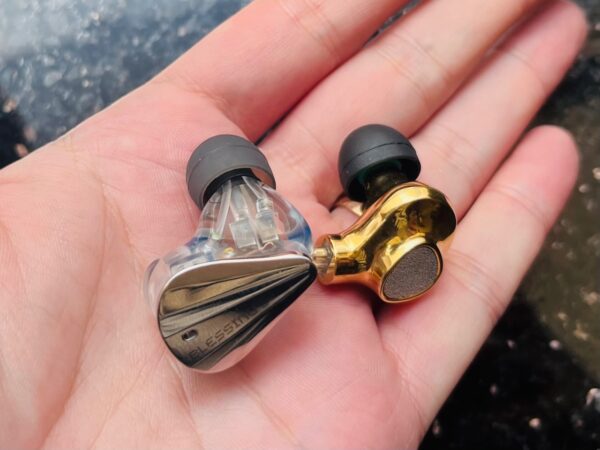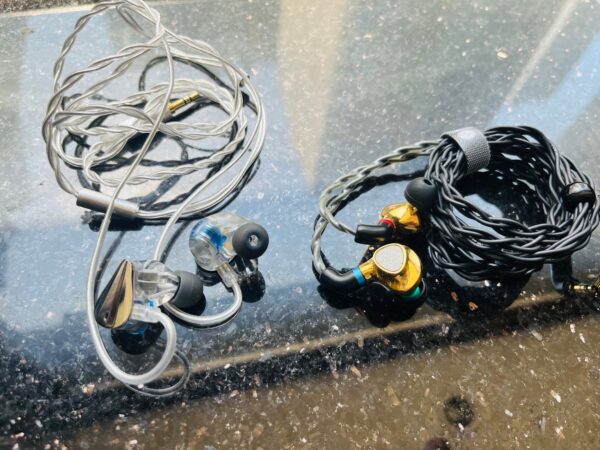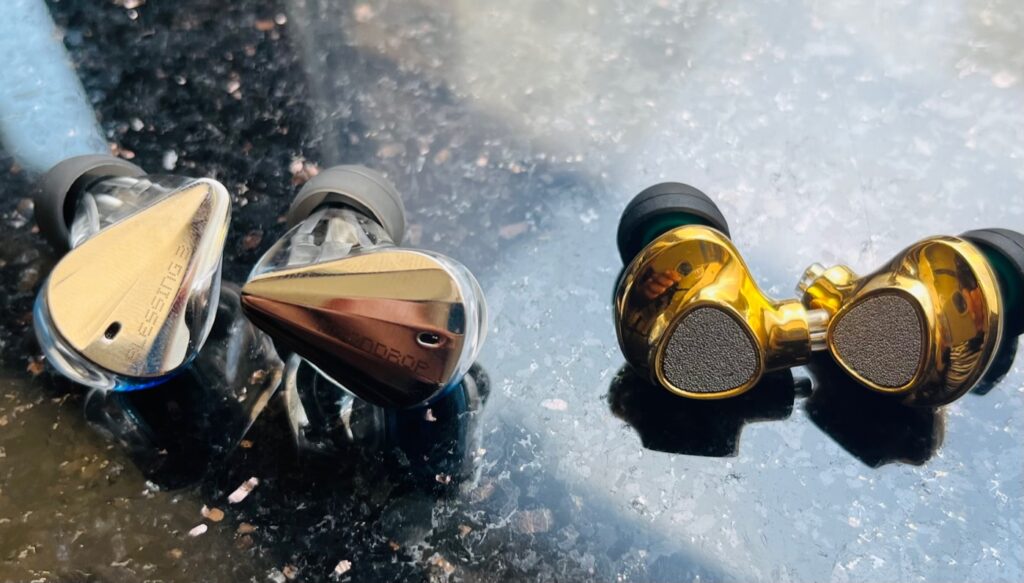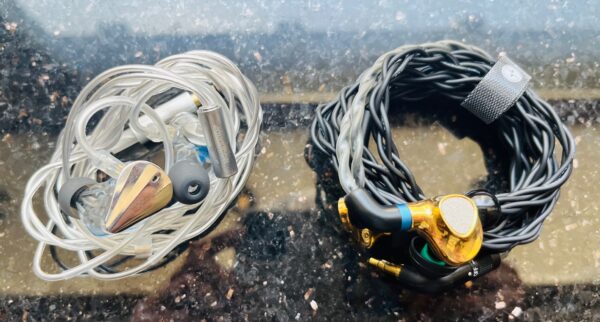There’s been a lot of hype about Moondrop’s Blessing 3 in the audiophile community. And for sure, it’s proving to be one of the best performing IEMs in the $300 price range. So, I was curious to see how it would stand up against other brands’ models that sell at similar price points. I decided to stack the Blessing 3 against the $370 TINHiFI P2, which is one of my favorite sound signatures in this echelon of IEMs. Which IEM is the better performer, and which sound signature will speak to you most?
Note that the TINHiFi photos featured in this review show the P2+, which is the gold limited edition version of the P2.
In the Box
|
Moondrop Audio Blessing 3 |
TINHiFi P2 |
| Moondrop Blessing 3 | TINHiFi P2 IEMs |
| 2-Pin Cable with 3.5mm Termination | Interchangeable 2-pin cable: 2.5mm, 3.5mm, 4.4mm |
| Carrying Case | Carrying Case |
| 6 pairs of silicone tips | 3 pairs silicone tips, 3 pairs of foam tips |
| Tweezers | |
| Cleaning tool |
Look and Feel
In terms of ergonomics, the Blessing 3 seems to have the upper hand. While I had little problem finding a good fit with the P2, its unconventional shell shape may prove incompatible with some ears. Or at least, the sound isolation may be less than optimal. In contrast, the generously rounded shells of the Blessing 3 fit more snugly and securely in my ear and felt just as comfortable.
With respect to build quality, the P2 appears a bit more durable, protected by two pieces of stainless steel and a reinforced 2-pin connector. In comparison, the Blessing 3 has a slightly more fragile looking build, especially if comparing its relatively flimsy 2-pin cable with the sturdier looking cable of the P2.

Design
The main design elements to note here are that the Blessing 3 incorporates a combination of two dynamic drivers and four balanced armature drivers, while the P2 features a 12mm planar driver. And the resulting contrast in sound signature between these two IEMs make these design differences quite obvious.
Given that the P2 has a planar magnetic driver and higher impedance than the Blessing 3, it takes quite a bit more power to get it to sufficient volumes. So, while the Blessing 3 can easily be driven from a phone, the P2 might require a portable DAC/Amp to get the optimal performance. For the purposes of this review, I paired both IEMs with the Dragonfly Cobalt DAC/Amp dongle.
Sound Impressions
Soundstage
With the respect to soundstage, one of the contrasting factors between the two models lies in the enhanced richness and completeness of distant instruments on the P2, which tends to be a characteristic of planar technology that more traditional drivers can’t often replicate. Consequently, the P2 showcases a more vibrant and diverse range of sound. The being said, in terms of imaging, both IEMs reveal ample dimension, even if the P2 reveals a little more height and presents slightly more nuanced gradations in instrument placement.
Low-End
Though both IEMs deliver some solid bass oomph, the P2 presents a richer, more velvety tone, while the Blessing 3 is dry and more textured. Both IEMs also reveal significant sub-frequency presence, though again, the P2 offers a thicker, more fluid timbre. The P2’s bass is also a little faster than that of the Blessing 3. Listening to acoustic bass instruments, both IEMs were highly revealing. But the P2 delivered the performance in with a more colorful and sumptuous quality, while the Blessing 3 felt less saturated and more natural.
Mids
The tuning in the mids is one of the main differences between these two IEMs. While the P2 delivers a good dose of low-mid presence, the Blessing 3 drops that weight, instead favoring the upper mids. As a result, the P2 sounds lush and full bodied (though it still gives some upper-mid kick), while the Blessing 3 is comparatively light and dynamic. The Blessing 3’s presentation is also thicker with gentler resolve, while the Blessing 3 sounds comparatively lean, crisp and life-like. But both IEMs offer very clean midranges, with notably tidy layering, even in the heaviest of mixes.
High-End
Both IEMs do a great job in the highs, though they have quite different characteristics. The P2 has more sparkle (incredible sparkle, in fact), while the Blessing 3 is less shiny but more crisp. So, while the P2 makes percussion feels shimmery in this range, the Blessing 3 presents the with a dryer, snappier feel. As a result, the P2 again feels more colorful, while the Blessing 3 presents as tighter and more funky. It should be notes that I didn’t experience any fatigue on either IEM at the highest treble peaks. In fact, neither models seem to reach piercing levels, so, sensitive ears rejoice.
Summary
While I’m the first to support dynamic and BA drivers, it’s hard to deny the added richness and suppleness that planar technology can deliver. And at the end of the day, the differences between these two IEMs are based less on skill than they are on personality. If you like a tight, natural, lively and crisp sound signature, the Blessing 3 is hard not to enjoy. But if you prefer a more substantial sound, with a fuller midrange, more sparkle and deeper tones throughout, the P2 would be the more ideal option. And given that the P2 comes with a high quality balanced cable and the option of two balanced plugs, the choice becomes a little easier.
You can buy the Moondrop Audio Blessing 3 and TINHiFi P2 at Audio 46.
Specifications
| Moondrop Audio Blessing 3 | TINHiFi P2 | |
| Driver | 2 Dynamic, 4 Balanced Armature | 12mm Planar Magnetic |
| Frequency Response | 20-40kHz | 10-20kHz |
| Impedance | 14.8 Ohms | 32 Ohms |
| Sensitivity | 120 dB |

About Author
You may also like
-
Dunu Titan S2 Review
-
Moondrop Evo HiFi True Wireless DAC/AMP Review
-
Lenbrook Media Group Partners with HDtracks to Create Streaming Service for Music Enthusiasts and Audiophiles
-
Meze Announcing ALBA IEMs – A New Budget Friendly IEM at $159
-
Ferrum Has Announced a New Hypsos Dual-Outpt, Goldsound Wandla, and Erco GEN 2


